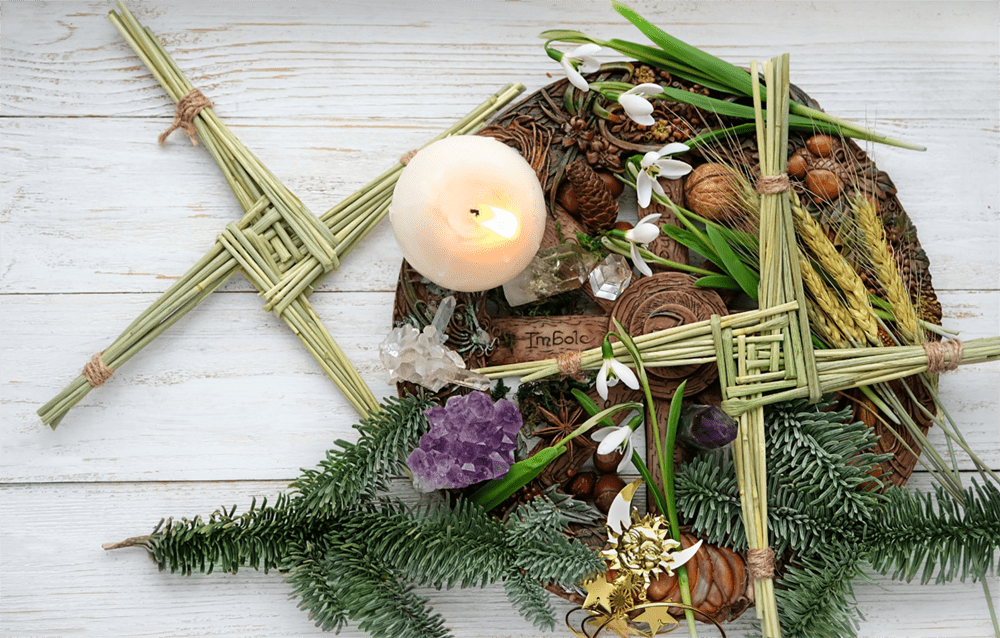Candlemas is celebrated on February 2: Whereas on February 1 there is a pagan Imbolc celebration. Also known as (Imblog, Imbole, or Oimelc) it is a fire festival linked to the winter solstice and the spring equinox linked to the Celtic goddess Brigid or Brigit.
Imbolc is well known as an ancient Celtic and Gaelic tradition originating in Neolithic Ireland and Scotland, commemorating the midpoint between the Winter Solstice and the Spring Equinox.
Celebration, prophecy, purification, and initiation: Candlemas (Christian), New Year (Tibetan, Chinese, and Iroquois), Tu Bi-Shevat (Jewish). Goddess Festivals: Feast Day of St. Brigit, Brighid, and Brigid (Celtic).
Traditional Imbolc and Candlemas 2023
Incense: Frankincense, Rosemary, Myrrh, and Cinnamon
Decorations: Spring Flowers, a Corn Dolly, and a Besom
Colours: Red, White, and Orange
- Candlemas and Brigid’s (pronounced “breed”) Day are other names for this occasion.
- one of four “Fire Festivals” in Celtic history.
- celebrates the transformation of the goddess from Crone to Maiden.
- celebrates the arrival of the first indications of spring.
- also known as “Imbolc” (the old Celtic name).
Candlemas is celebrated on February 2nd and is known as the “Feast of the Presentation of Jesus Christ”, “Feast of the Purification of the Blessed Virgin Mary”, or the “Feast of the Holy Encounter”. Whereas Imbolc is a festival of light and ushers in the first signs of spring.
In the depths of winter, there is a whisper of warmer weather and an ember of hope. The Crocus and perennial bulbs begin to bloom, while hellebore, snowdrops, iris, and daffodils are frequently the first flowers to arrive in the spring.
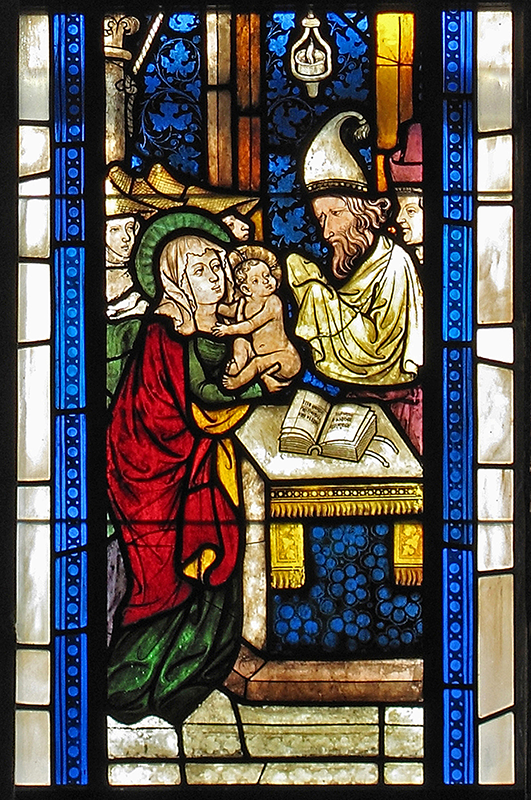
What about Imbolc and the Moon?
Each cross-quarter day (Imbolc, Beltane, Lammas, and Samhain) has a bonus “Lunar Holy Day” to commemorate it.
They correspond to the New and Full Moons in Aquarius and Scorpio, respectively:
- The New Moon in Aquarius commemorates Lunar Imbolc (dark, seeds-of-the-future, germinating time).
- The full moon in Scorpio is known as “Lunar Beltane” (think candlelight and flirtatious fun with your close-ins).
- It’s Lunar Lammas when the full moon is in Aquarius (a beautiful time to share your harvest bounty around a blazing hearth fire with a chosen family).
- The New Moon in Scorpio commemorates Lunar Samhain, an auspicious time to drop into the deep for soul work and ancestral healing.
These lunar holy days can fall either before or after their sister fire festival dates. Serious Moon devotees frequently honour the lunar holy day rather than, in addition to, the more commonly celebrated days.
In a figurative sense, Imbolc is a great time to spend time in the darkroom and watch what is coming up.
The visuals may be hazy because it is dark and the future is unknown. Use the resources at your disposal (the Tarot, a scrying pool, drawing pencils, and firelight) to foresee what lies ahead. Set your eyes on the road that will result in the best outcome for yourself, your family, and your community. Your will is strong.
Celebrations of Imbolc around the World and Chinese New Year
Imbolc is frequently marked by fire rituals, bonfires, or gatherings. It is often referred to as an internal holiday. Imbolc can be celebrated with solitude in nature or calm hikes.
Candlemas is a Christian feast commemorating Jesus’ presentation in the Temple. This is often a time when people clean their homes and take down all of their Christmas decorations, or they bring candles to places of worship.
France and Belgium: Candlemas is traditionally celebrated in France and Belgium with crêpes or pancakes and candles illuminating the entire family. The focus of Luxembourg’s celebration is on children. In exchange for food and candy, children march around the streets with lanterns and sing to their villages. Puerto Rico celebrates with a candlelit march to the “Virgen de la Candelaria” statue. Others will light bonfires or burn their Christmas trees.
China: In 2023, the Chinese New Year begins on January 22nd and ends on February 5th with the Lantern Festival.
North America: On February 2nd, much of North America celebrates Groundhog Day. This celebration is associated with weather-lore involving a badger or groundhog, a Germanic weather-predicting animal that predicts how many more weeks of winter there will be before spring.
According to legend, if a groundhog emerges from his hollow or nest on February 2nd and sees its shadow, six more weeks of winter weather will endure. If, on the other hand, the day was cloudy and the groundhog did not see its shadow, it was an indication that the weather in the coming weeks would result in an early spring.
Celtic Festivals and Imbolc dates
The four cardinal points of the year are marked by pairs of solstices and equinoxes and combine with the four cross-quarter divisions to create the eight solar divisions: Imbolc (1-2 Feb.), Beltaine (1-2 May), Lughnasa (1st Aug.), and Samhain (1st Nov.). In fact, the origins of the Pagan calendar are believed to be lunar, but it appeared to have adopted the solar calendar around the time of Christianity, when Christian traditions celebrate Candlemas (Imbolc), May Day Virgin Mary (Beltaine), Lammas (Lughnasa), and All Saints Day (Samhain).
Major Solar events the Celts followed
Brigid’s name translates as “Fiery Arrow,” and according to legend, she was the daughter of Dagda, the head of the Tuatha Danann. There is an article on the website about Halloween, which includes the Celtic Fire Festival and the legends of tuatha dé danann. Also, there are articles in the Templarkey magazine, issue 2 [January 2022] “The Druids” and issue 3 [April 2022] “The Culdees” for those interested in learning more about The Druids and The Culdees.
Celtic Goddess Brigid, Bridget, and Brigit
Many Imbolc festivals worshipped the pagan goddess Brigid or Bridget (Brigid’s day was celebrated as the day of Imbolc and a seasonal festival), which is associated with fertility, prophesy, and fire. Saint Brigid shares many of the goddess’s attributes, and her feast day, 1 February, was originally a pagan festival called Imbolc.
It has thus been argued that the saint is a Christianization of the goddess or that the lore of the goddess was transferred to her. See on the Internet Archive site Pamela Berger, The Goddess Obscured: Transformation of the Grain Protectress from Goddess to Saint.
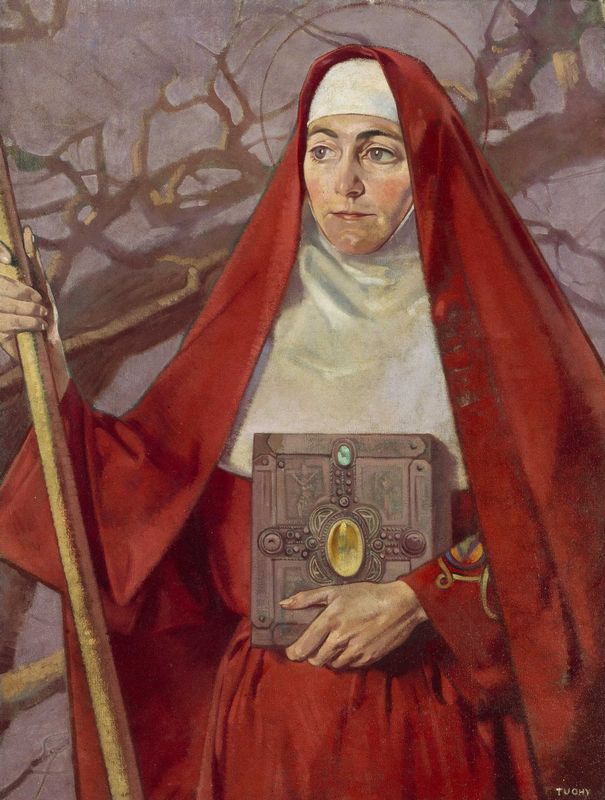
Why is St. Brigid no longer a saint? The Fertility Goddess
The patron saint of Ireland is no longer Saint Brigid. There is still a saint named Brigit or Bridget, but she’s Bridget of Sweden. She seems to have three different feast days, one in July and two in October. Meanwhile, our unfortunate Brigid has none now. The suspicion is that she was stripped of her status just because she shared a name with the pagan goddess Brigid.
Goddess Festivals: Saint Brigit, Brighid, and Brigid’s Feast Days (Celtic).
Brigid, on the other hand, is a Celtic fertility and motherhood goddess celebrated in early February; therefore, Imbolc is a pagan religious festival in which Brigid is honoured and thus linked to the change of seasons.
She is also a creative goddess who favours artisans, passion, creativity, and creation; therefore, Brigid is a goddess of poetry.
She is a goddess of complexities and contradictions, much like her season. She is a fertility goddess, and Brigid is credited with and known for healing and childbirth, as well as passion and fire. This season exemplifies the contradiction between the promise of spring and the severity of winter.
Brigid is frequently shown as a Fire Goddess with a cauldron or vessel nearby
She has a strong link with the sun as she is said to have a flame in her head, and Imbolc itself is reflected in the sun’s return to the planet as winter’s lessening on the earth reaches its climax. The sun shines brighter, and the evenings become shorter.
Brigid is known as the “Queen of Death Rituals” in Ireland. She, like many mother deities, can rule over both life and death. She usually lives in and guards cemeteries.
Brigit (Brigid, Brighid, Bríd, Bride, Bridget) (possibly c.450–524), reputed foundress and first abbess of Cell Dara (Kildare), is the female patron saint of Ireland, but it is uncertain whether she existed as a person. Most scholars regard her as a ghost personality generated in the period of transition from paganism to Christianity, replacing the pagan goddess Brigit, the Irish manifestation of the Celtic Brigantia. There is no contemporary evidence for St Brigit, but she, or her cult, is well documented in the annals, hagiography, genealogies, and liturgical literature.
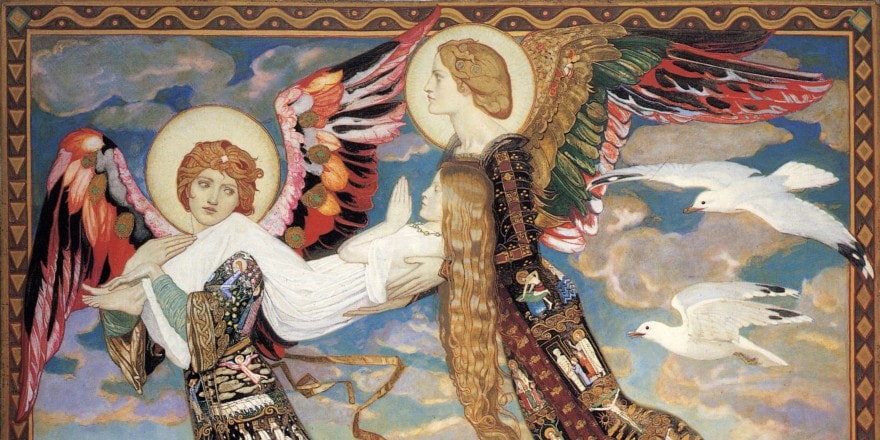
Imbolc Customs
- Plan or plant a garden: Imbolc is a fantastic time to start planning your garden! Spend some time today planning your garden cycle or starting tiny seedlings to grow for Equinox.
- Take a nature walk: Many plants have already begun to emerge from the gloom. Crocuses, daffodils, hellebores, and iris are all starting to bloom. Look for signs of spring outside.
- Construct an Imbolc altar: Collect fresh herbs and sprouts to decorate the altar. Always bring a candle, because Imbolc is all about light. Use dead leaves or brush to commemorate the end of winter. Make or draw a Brigid’s cross in the centre. Within a future Templarkey magazine, there will be an article where you can learn more about altar building.
- Candles and fire: In many Imbolc rituals, fire represents a traditional aspect and a welcoming face. Light candles throughout your home or build a bonfire outside in the cool night air.
- Setting intentions: Imbolc, which occurs just after the new year, is a reflective time to dig deeply into your aims and plans for the following spring. Meditate or journal with your intentions, and consider what you want to tend and grow in yourself and your world this year.
- Spring Cleaning and Purification Ritual: To make room for fresh energy, clean your space with salt or smoke. Allow the ever-changing air to flow through your home by opening the windows. Take the literal approach and begin spring cleaning early. Start a donation box to get rid of unwanted stuff or old memories. Make room in your body and home for the surge of new energy that spring brings.
How do you construct an Imbolc Cross?
The Brigid’s cross is often built from reeds and put on top of a doorway or window to ward off evil spirits and protect the house from damage.
While making the crosses, which are named after the pagan goddesses of healing, poetry, smithcraft, fire, and the hearth, rituals are often performed.
She is usually worshipped during Imbolc because she is believed to bring fertility to the land.
Making a Bridey or Brigid’s doll
A “bridey dol”l can be made from dried raffia or cloth stuffed with wool, herbs, and dried flowers, therefore linking the agricultural year to farming for the coming year.
To build a simple one, use dried raffia (available at stores such as HobbyCraft) – fold the raffia into the arms first and secure it with elastic bands.
Then, using extra elastic bands to build a head and another band to hold the arms in place and create the skirt, put them through another cluster of raffia.
Snip any strands that are out of position and place the “bridey doll” on the mantlepiece to finish it up. Some people also include a scrap of paper with a prayer or wish for the next year, and the doll might be decorated with beads and ribbons.
For Imbolc, here’s how to construct Brigid’s cross.
Brigid’s crosses are fashioned from reeds or willow, or anything found in hedgerows or along river banks, or, if all else fails, straw or paper. Bend the reed, straw, or paper and join them together to form a cross. Repeat this process until you have four arms, each densely packed with reeds.
You’ll need to connect these arms together with more reeds and snip them off to make them nice and stylish.
Then, tie the four ends together with string or ribbon and embellish the cross with feathers, beads, or something else significant. After that, hang it above a doorway or window.
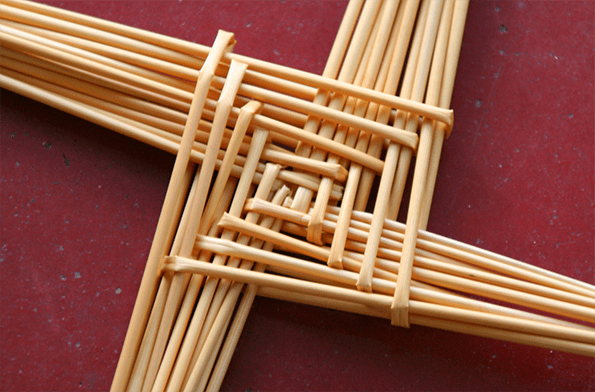
What exactly is Wicca?
Wicca, an alternative minority religion whose practitioners, regardless of gender, refer to themselves as witches, first appeared in the United Kingdom in the 1940s. We have a dedicated “Witchcraft Special Edition Magazine” issue 8 [July 2023] for those interested in Witchcraft that includes the following articles:
- Witch Walking, Moon Circles, Pilgrimages & Holy Wells.
- Witchcraft in France, Pagan Temples & Christian Witches.
- Witchcraft & Christian Witches.
- Were The Pendle Witches Executed for being Roman Catholic?
- Is Wicca Witchcraft, or is a Witch a Wiccan?
- Popular Christianity, America & Voodoo.
Wicca and witchcraft are part of a larger current pagan movement that also includes druids and heathens. All of these “spiritual paths,” as pagans call them, are based on pre-Christian religions and cultures.
Since its arrival in the United States in the 1960s, Wicca has been growing, sometimes rapidly, sometimes slowly. It is estimated that there are approximately 1.5 million witches in the United States.
However, as we have discovered through my own extensive investigation over the past 30 years, not all witches consider themselves Wiccans. According to the most recent poll data, around 800,000 Americans practice Wicca. The increasing numbers shown in polls, as well as the emergence of groups like those on TikTok, indicate that the religion is expanding.
A stand-alone practice
The religion distinguishes itself from other prominent religions, such as Christianity, by honouring both a goddess and a god. Furthermore, unlike a religion, Wicca lacks a formal institutional framework and places a greater focus on ritual and direct spiritual experience rather than dogma. Adherents call themselves practitioners rather than believers.
Sabbats are a yearly cycle of rituals that mark the beginning and peak of each of the four seasons in the Northern Hemisphere. Each ritual encourages participants to enjoy the changes that the seasons bring to nature while also reflecting on how those changes reflect in their own lives.
Wiccans, for example, celebrate fertility in both the Earth and people’s lives on Beltane, which occurs on May 1 at the height of spring. The ceremonies are designed not merely to commemorate the season but also to bring the person into direct contact with the divine.
Wiccans have one overarching rule: “Have no harm and do as you will,” and no particular religious scripture from which they take their views. Most Wiccans worship alone and are allowed to create their own distinct rituals. They maintain regular touch, networking on the internet and convening in large groups to perform rituals, learn about magical and spiritual practices from one another, and enter what they perceive to be a magical environment where they can more easily experience and embrace god.
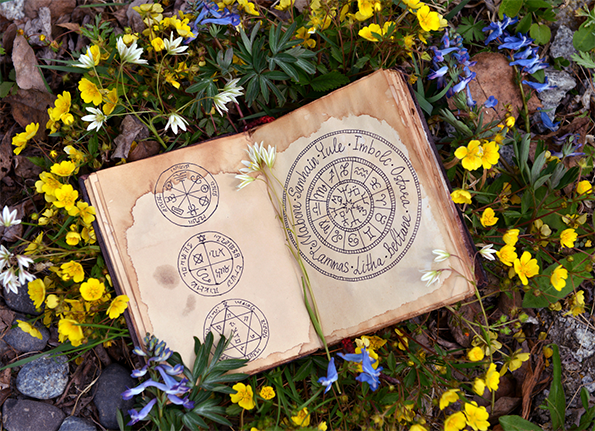
A religion for the twenty-first century
Although many Wiccans claim to be inspired by historical cultures such as pre-Christian Anglo-Saxon and Celtic traditions, it is very much a modern religion. The goddess gives the divine a feminine face, appealing to feminists and those seeking “girl power.” Wiccans see divinity in nature, which connects with growing environmental concerns, especially among young people.
Most Wiccans perform magic, which they believe connects them to a spirit dimension known as the “otherworld.” Others see magic as drawing on an energy field that they think surrounds us all. They utilize magic to heal themselves and others, as well as to locate a new home or career, and they emphasize that magic must not cause harm. Magic is thought to change practitioners as much as their surroundings, inspiring followers to strive for self-growth and self-empowerment.
